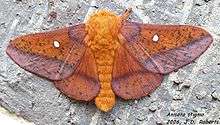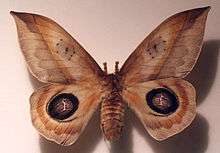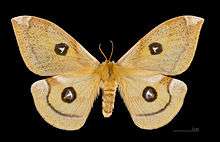Saturniidae
| Saturniids | |
|---|---|
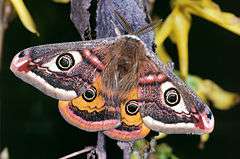 | |
| Male small emperor moth, Saturnia pavonia (Saturniinae) | |
| Scientific classification | |
| Kingdom: | Animalia |
| Phylum: | Arthropoda |
| Class: | Insecta |
| Order: | Lepidoptera |
| (unranked): | Macrolepidoptera |
| Superfamily: | Bombycoidea |
| Family: | Saturniidae |
| Subfamilies | |
|
Oxyteninae | |
The family Saturniidae, commonly known as saturniids, by most measures include the largest species of moths. They are a family of Lepidoptera, with an estimated 2,300 described species worldwide.[1] The Saturniidae include such Lepidoptera as the giant silkmoths, royal moths and emperor moths.
Adults are characterized by large size, heavy bodies covered in hair-like scales, lobed wings, reduced mouthparts, and small heads. They lack a frenulum but the hind wings overlap the forewings, producing the same effect of an unbroken wing surface.[2] These moths are sometimes brightly colored and often have translucent eyespots or "windows" on their wings. Sexual dimorphism varies by species, but males can generally be distinguished by their larger, broader antennae. Most adults possess wing spans between 1 and 6 in (2.5 and 15 cm), but some tropical species, such as the Atlas moth (Attacus atlas), may have wing spans up to 12 in (30 cm). Together with certain Noctuidae (chiefly Calpinae and Catocalinae, such as the genera Ascalapha, Erebus, or Thysania), the Saturniidae contain the largest Lepidoptera, and some of the largest insects alive today.
Distribution

The majority of saturniid species occur in wooded tropical or subtropical regions, with the greatest diversity in the New World tropics and Mexico,[2] though they are found all over the world. About 12 described species live in Europe, one of which, the emperor moth, occurs in the British Isles, and 68 described species live in North America, 42 of which reside north of Mexico and Southern California.
Lifecycle
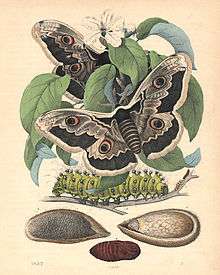
Some saturniids produce more than one brood a year. Spring and summer broods hatch in a matter of weeks; autumn broods enter a state known as diapause and emerge the following spring. How the pupae know when to hatch early or hibernate is not yet fully understood, though research suggests day length during the larval fifth instar plays a major role. Longer days may prompt pupae to develop early, while shorter days result in pupal diapause. The number of broods is flexible, and a single female may produce both fast-developing and slow-developing individuals, or they may produce different numbers of broods in different years or parts of the range.[2] In some species – e.g. the luna moth (Actias luna) or Callosamia securifera (both Saturniinae) –, spring and summer broods look different, with different genes activated by environmental conditions.[2]
Eggs
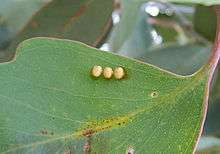
Depending on the moth, a single female may lay up to 200 eggs on a chosen host plant. Others are laid singly or in small groups.[3] They are round, slightly flattened, smooth and translucent or whitish.
Larvae
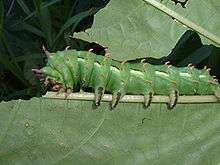
Saturniid caterpillars are large (50 to 100 mm in the final instar), stout, and cylindrical. Most have tubercules that are often also spiny or hairy. Many are cryptic in coloration, with countershading or disruptive coloration to reduce detection, but some are more colourful. Some have stinging hairs.[3] A few species have been noted to produce clicking sounds with the larval mandibles when disturbed (e.g. Saturniini like Actias luna and the polyphemus moth, Antheraea polyphemus). The clicks may serve as aposematic warning signals to a regurgitation defense.[4]
Most are solitary feeders, but some are gregarious. The Hemileucinae are gregarious when young and have stinging hairs,[2] those of Lonomia containing a poison which may kill a human. A. armida is another well-known example, and are infamous for their large conspicuous masses during the day. Their coloration is not cryptic, instead exhibiting aposematism.
The other caterpillars in this size range are almost universally Sphingidae, which are seldom hairy and tend to have diagonal stripes on their sides. Many Sphingidae caterpillars bear a single curved horn on their hind end. These are actually not dangerous, but large-haired caterpillars should generally not be touched except by experts.
Most saturniid larvae feed on the foliage of trees and shrubs. A few, particularly Hemileucinae such as Automeris louisiana, A. patagonensis, and Hemileuca oliviae, feed on grasses. They moult at regular intervals, usually four to six times before entering the pupal stage. Prior to pupation, a wandering stage occurs, and the caterpillar may change colour, becoming more cryptic just before this stage.[2]
Pupae
Most larvae spin a silken cocoon in the leaves of a preferred host plant or in leaf litter on the ground, or crevices in rocks and logs. While only moderately close relatives to the silkworm (Bombyx mori) among the Lepidoptera, the cocoons of most larger saturniids can be gathered and used to make silk fabric. However, larvae of some species – typically Ceratocampinae, like the regal moth (Citheronia regalis) and the imperial moth (Eacles imperialis), burrow and pupate in a small chamber beneath the soil. This is common in the Ceratocampinae and Hemileucinae. Unlike most silk moths, those that pupate underground do not use much silk in the construction.[2] Once enclosed in the cocoon, pupae undergo metamorphosis.
Adults
Adult females emerge with a complete set of mature ova and "call" males by emitting pheromones (specific "calling" times vary by species). Males can detect these chemical signals up to a mile away with help from sensitive receptors located on the tips of their feather-like antennae. The males fly several miles in one night to locate a female and mate with her; females generally will not fly until after they have mated.
Since the mouthparts of adult saturniids are vestigial and digestive tracts are absent, adults subsist on stored lipids acquired during the larval stage. As such, adult behavior is devoted almost entirely to reproduction, but the end result (due to lack of feeding) is a lifespan of a week or less once emerged from the pupa.
Importance to humans
A few species are important defoliator pests, including the orange-striped oakworm moth (Anisota senatoria) on oaks, the Pandora pinemoth (Coloradia pandora) on pines and Hemileuca oliviae on range grasses.
Other species are of major commercial importance in tussah and wild silk production. These notably include the Chinese tussah moth (Antheraea pernyi), its hybridogenic descendant Antheraea × proylei, and the Ailanthus silkmoth (Samia cynthia). In 2015, Adarsh Gupta K of Nagaraju's research team at Centre for DNA Fingerprinting and Diagnostics, Hyderabad, India discovered the complete sequence and the protein structure of Muga Silk Fibroin and published it in Nature (journal) Scientific Reports [5]
Many species of Saturniidae are a valuable food source for man in sub-Saharan Africa, examples being the Mopane worm (Gonimbrasia belina), Gonimbrasia zambesina, the cabbage tree emperor moth (Bunaea alcinoe), Gynanisa maia, Imbrasia epimethea, Imbrasia oyemensis, Melanocera menippe, Microgone cana, Urota sinope and the pallid emperor moth (Cirina forda).[6][7][8][9]
Caterpillars of the genus Lonomia produce a deadly toxin injected into the victim when it is touched.[10]
Most Saturniidae are harmless animals at least as adults, and in many cases at all stages of their lives. Thus, some of the more spectacular species – in particular Antheraea – can be raised by children or school classes as educational pets. The soft, silken cocoons make an interesting keepsake for pupils.
Systematics and evolution
In terms of absolute numbers of species, the Saturniidae are most diverse in the Neotropics. Also, their most ancient subfamilies occur only in the Americas. Only the very "modern" Saturniidae are widely distributed across most parts of the world. Thus, it is quite safe to assume – even in the absence of a comprehensive fossil record – that the first Saturniidae flew around in the neotropical region. Note that at least two of the subfamilies included below are commonly treated as separate families (Oxyteninae and Cercophaninae).
The following list arranges the subfamilies in the presumed phylogenetic sequence, from the most ancient to the most advanced one. Some notable genera and species are also included.
- Subfamily Oxyteninae (three genera, 35 species)
- Subfamily Cercophaninae (four genera, 10 species)
- Subfamily Arsenurinae (10 genera, 60 species, Neotropics)
- Paradaemonia Bouvier, 1925
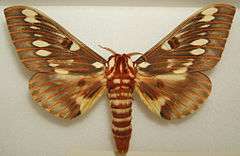
- Subfamily Ceratocampinae (27 genera, 170 species, Americas)
- Adeloneivaia
- Anisota
- Anisota senatoria – orange-striped oakworm moth
- Citheronia
- Citheronia azteca
- Citheronia lobesis
- Citheronia regalis – regal moth
- Citheronia sepulcralis – pine-devil moth
- Dryocampa
- Dryocampa rubicunda – rosy maple moth
- Eacles
- Eacles imperialis – imperial moth
- Syssphinx
- Subfamily Hemileucinae (51 genera, 630 species, Americas)
- Automeris
- Automeris io – Io moth
- Coloradia
- Hemileuca
- Hemileuca nevadensis – Nevada buck moth
- Hemileuca maia – buck moth
- Lonomia
- Ormiscodes
- Automeris
- Subfamily Agliinae (one genus, three species)
- Subfamily Ludiinae (disputed) (eight genera, Africa)
- Subfamily Salassinae (one genus, 12 species, tropics)
- Subfamily Saturniinae (59 genera, 480 species, tropical and temperate regions worldwide)

References
- ↑ van Nieukerken; et al. (2011). "Order Lepidoptera Linnaeus, 1758. In: Zhang, Z.-Q. (Ed.) Animal biodiversity: An outline of higher-level classification and survey of taxonomic richness" (PDF). Zootaxa. 3148: 212–221.
- 1 2 3 4 5 6 7 Tuskes et al. (1996)
- 1 2 Scoble (1995)
- ↑ Brown et al. (2007)
- ↑ Adarsh Gupta. K. "Molecular architecture of silk fibroin of Indian golden silkmoth, Antheraea assama".
- ↑ "Edible insects: future prospects for food and feed security" - van Huis et al. (2013)
- ↑ "Food Insects Newsletter"
- ↑ "Food Insects"
- ↑ "Insects as food in Sub-Saharan Africa" - A. van Huis
- ↑ More Media Coverage. "Caterpillar-induced bleeding syndrome in a returning traveller". Cmaj.ca. Retrieved 2011-10-18.
| Wikimedia Commons has media related to Saturniidae. |
- Brown, S.G.; Boettner, G.H. & Yack, J.E. (2007): Clicking caterpillars: acoustic aposematism in Antheraea polyphemus and other Bombycoidea. J. Exp. Biol. 210(6): 993-1005. PDF fulltext
- Scoble, M.J. (1995): The Lepidoptera: Form, Function and Diversity (2nd ed.). Oxford University Press.
- Tuskes, P.M.; Tuttle, J.P. & Collins, M.M. (1996): The wild silk moths of North America. Cornell University Press. ISBN 0-8014-3130-1
- Latham, P. (2008) Les chenilles comestibles et leurs plantes nourricières dans la province du Bas-Congo. PDF fulltext
- Latham, P. (2015) Edible caterpillars and their food plants in Bas-Congo province, Democratic Republic of Congo. PDF fulltext
Further reading
- Burnie, David (2001). Smithsonian: Animal (1st American ed.). DK Publishing Inc., 375 Hudson St. New York, NY 10014.
- Mitchell, Robert T. (2002). Butterflies and Moths: A Golden Guide From St. Martin's Press. St. Martin's Press, New York.
- Racheli, L. & Racheli, T. (2006): The Saturniidae Fauna of Napo Province, Ecuador: An Overview (Lepidoptera: Saturniidae). SHILAP Revista de Lepidopterología 34(134): 125-139. PDF fulltext (inventory of about 200 Saturniidae taxa)
- Lampe, Rudolf E. J. (2010) Saturniidae of the World – Pfauenspinner der WeltTheir Life Stages from the Eggs to the Adults -Ihre Entwicklungsstadien vom Ei zum Falter [English and German] ISBN 978-3-89937-084-3
External links
- Moths of North America: Saturniidae
- Bombycoidea of Canada
- Family Classification of Lepidoptera
- University of Kentucky Entomology: Saturniid Moths
- Moths (Saturniidae) of the United States
- How to rear saturniid moths
- Saturniidae of Europe
- Saturnia-Homepage
- Saturniidae-web.de
- Images of Saturniidae species of New Zealand
- Photos tagged with "saturniidae" at Flickr
